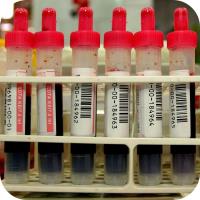 “How can you hope to cure something if you don’t know what the cause of the problem is?” This was the question my old university professor would always ask whenever one of the class would attempt to treat a symptom which we hadn’t fully investigated. That statement is as true today as when I was studying, which is why doctors should always refer you for fertility tests before recommending any treatment.
“How can you hope to cure something if you don’t know what the cause of the problem is?” This was the question my old university professor would always ask whenever one of the class would attempt to treat a symptom which we hadn’t fully investigated. That statement is as true today as when I was studying, which is why doctors should always refer you for fertility tests before recommending any treatment.
In this section I cover the basics of the standard fertility tests that all couples who are experiencing difficulties getting pregnant should take. While the description of each test is brief and to the point, if you want to go into detail about what a particular test involves, how to prepare for it and how to interpret the results, then there is the option to explore it further.
To help you, I have listed the tests below and if you wish to jump to a particular test, simply click on the name:
Fertility Tests for Women
• Fertility Blood Tests for Women
• Pelvic Ultrasound
• Fallopian Tubes X-Ray (Hysterosalpingogram)
• Chlamydia and Gonorrhoea Test (Female)
• Laparoscopy Operation
Fertility Tests for Men
• Semen Analysis Test
• Fertility Blood Tests for Men
• Chlamydia and Gonorrhoea Test (Male)
Fertility Tests for Women
Blood Tests
Fertility blood tests look at the hormone levels in your blood at two different times in your menstrual cycle. Depending on the amount and combinations of these hormones, the blood tests can diagnose Premature Ovarian Failure (POF), Low Ovarian Reserve, Polycystic Ovary Syndrome (PCOS), Anovulation, and low body weight related issues.
In addition to these standard blood tests, your doctor may send you for additional tests if you have certain symptoms, a family history of disease or come from a particular genetic background. The additional blood tests are for Thyroid Problems, Rubella, Hepatitis B & C, HIV, Sickle Cell, and Thalassaemia. To find out more about the procedure for fertility blood tests, what hormones are being tested and how to interpret the results, check out the section: Fertility Blood Tests for Women.
Pelvic Ultrasound
A pelvic ultrasound test is used to check the health of the woman’s ovaries, uterus and fallopian tubes. It uses high-frequency sound waves to create images of your internal organs. It is looking for polycystic ovaries, fibroids, and any other structural abnormalities. It is carried out in a hospital or clinic and can either be done transabdominally (through the abdomen) or transvaginally (through the vagina). It is considered very safe and there are no known risks with the procedure. To learn more about how to prepare, what the procedure entails, what they are looking for and the results, check out the section: Fertility Ultrasound Scan.
Fallopian Tubes X-Ray (Hysterosalpingogram)
A Hysterosalpingogram, also known as an HSG test, is a fertility test used to identify if there are any blockages in the woman’s fallopian tubes. The fallopian tubes link the ovaries to the uterus and a blockage could prevent the egg travelling through them to the uterus. The HSG test is carried out in a hospital or clinic. It involves injecting an x-ray dye into the uterus through the cervix while being x-rayed by a fluoroscope (real time x-ray imager). The dye fills up the uterine cavity and if the fallopian tubes are open, it passes through them into the abdominal cavity. For more information on this fertility test, check out the section: Hysterosalpingogram (HSG Test)
Chlamydia and Gonorrhoea Test (Female)
Sexually Transmitted Diseases (STDs) are one of the biggest causes of infertility among couples. This test looks for the two most common STDs: Chlamydia and Gonorrhoea. As well as being the most common, these diseases often display no obvious symptoms.
Both Chlamydia and Gonorrhoea can cause Pelvic Inflammatory Disease (PID) in women. If these diseases are left untreated, they can cause permanent infertility.
The Chlamydia and Gonorrhoea test can either be done as a swab from the cervix, or as a urine test (though the urine test is less accurate). Find out more about this test in the section: Testing for Chlamydia and Gonorrhoea
Laparoscopy Operation

Laparoscopies are rarely used for fertility testing these days. Partially because other tests and treatments have become better, and partially because, as an operation, laparoscopies carry risks and even a small chance of death. However, it can still be a very useful fertility tool on the rare occasions that the benefits are thought to outweigh the risk.
The laparoscopy procedure involves having your abdomen filled with carbon dioxide gas to create a cavity and then a camera is inserted inside to view the reproductive organs. If any problems like scarring or endometriosis is spotted, it is possible to fix them at the same time as the laparoscopy is being performed. Luckily you won’t be awake while this is going on, as laparoscopies are performed in a hospital under general anaesthetic. To view a diagram of a laparoscopy, click here.
If your fertility doctor is recommending you have a laparoscopy, make sure they inform you of the risks and how they may affect you (for example; there is a small risk of infection and a 2 in 10,000 chance of death, but make sure you are told the risks for your specific situation). Also ask your doctor what alternatives are available, because IVF treatment bypasses some of the problems that a laparoscopy looks for, making it less worthwhile taking.
Fertility Tests for Men
Semen Analysis Test
This is the standard fertility test men will be sent to take by their doctor. It primarily looks at the number of sperm (sperm count), their shape (morphology), and how they move (motility). However, there are additional factors that may be looked at depending upon the laboratory undertaking the analysis. The test requires the man to produce a sample of semen in a sterile bottle, which he then needs to get to that laboratory with an hour. To learn more about how to prepare for the semen analysis test, what it involves and what the results mean, check out the section: Semen Analysis Test.
Fertility Blood Tests for Men
The most common male fertility blood test is the testosterone test. This checks the levels of the hormone testosterone, which is essential in sperm production. Low testosterone may also affect the man’s libido, making him less likely to want to have sex. In some cases, low testosterone is thought to contribute to erectile dysfunction, where the man has a problem getting and keeping an erection.
In addition to the testosterone test, if the man has diabetes, he may be sent for a blood test to ensure his diabetes is under control. He may also be sent for a blood test if his doctor suspects him of having a genetic disorder that could be affecting his fertility or which could affect the health of any future children he might have.
Find out more about male blood tests by checking out the section: Male Fertility Blood Tests.
Chlamydia and Gonorrhoea Test (Male)
Both Chlamydia and Gonorrhoea can cause ejaculatory duct obstruction in men. If these diseases are left untreated, they can cause permanent infertility.
The Chlamydia and Gonorrhoea test can either be done as a swab from the urethra (opening of penis), or as a urine test (though the urine test is less accurate). Find out more about this test in the section: Testing for Chlamydia and Gonorrhoea
Note: This test is not always performed for men, on the basis that if the woman has the test and it comes back negative, then the man is very unlikely to have one of these sexually transmitted diseases. However, this is bad practice and strictly speaking, the man should be tested for these too. This is because there have been cases where the woman is clear, yet the man is not (commonly in multi-partner couples).
What If They Don’t Find Anything?
The fertility tests listed above are the standard tests. They are not perfect and 70-80% of the time, they do not pick up any problems with either the man or the woman. When they don’t pick up anything, a diagnosis of Unexplained Infertility is often given. In some cases, where there are indications that other problems exist, further more complicated tests may be given.
If you are paying for private treatment, your provider may recommend you go for additional fertility tests. Before taking them up on their offer and potentially being charged for unnecessary work, discuss the merits of having these tests with your doctor.
- What is the test looking for?
- Why do you think that it is necessary for me to undertake this test?
- Would a positive result from the test change the treatment?
- What is the cost of any change in treatment?
- What scientific evidence is there that any proposed change in treatment improves fertility success rates?
This will help you to make an informed decision as to whether you think it is worthwhile parting ways with money for the test or not.
Home Fertility Tests
There are a number of home fertility tests available on the market. While these tests are improving all the time, they are not as good as a laboratory test. However, if you don’t want children right now, but want to do a fertility MOT, they are a lot cheaper than taking fertility tests in a private clinic. You should be aware that their accuracy can vary widely, so look for reviews before buying.
Links to Popular Related Pages
















